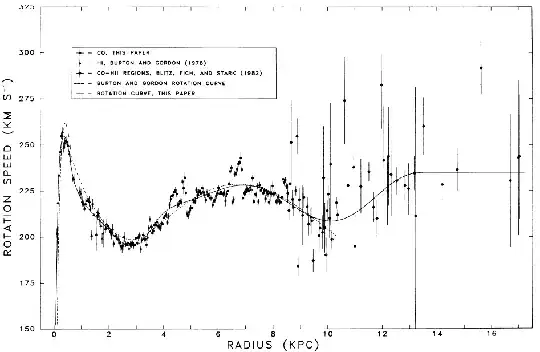The past days I have been studying the rotation curves of disk galaxies and I am currently trying to understand how we can extract information about the dark matter of a galaxy by looking its rotation curve. A typical and well behaved rotation curve of a disk galaxy rises fast at the start, then it peaks and produces a "hump"/"bump" and then it remains constant (or slightly declining). I would like to ask what exactly causes the "hump"/"bump" on the rotation curve and what it can tell us about the galaxy.
1 Answers
The first hump that you see is caused by the galactic disk. The gravitational potential for this is given by* $$ \Phi_{disk}=-\frac{GM_{disk}}{\left(r^2+(a+\sqrt{b^2+z^2})^2\right)^{1/2}} $$ where $a$ is the scale radius of the disk, $b$ the scale height, and all other variables take their usual meaning. The rotational velocity is then the square root of the $r$-derivative of $\Phi$ times r: $$ v_{rot,disk}=\left(\frac{GM_{disk}r^2}{\left(r^2+(a+\sqrt{b^2+z^2})^2\right)^{3/2}}\right)^{1/2} $$ If you plot this (with the appropriate units), you should get that first bump you ask about.
This particular bump can tell us two things:
- The scale radius
- The mass of the disk
A smaller value of $a$ will lead to a peak at shorter $r$ while also increasing the rotational velocity; a larger $a$ will lead to the opposite change. A larger $M_{disk}$ will produce a larger peak rotational velocity (assuming you fixed $a$, your model's peak would occur at the same point).
*There are other models of potentials, see Section 7.4 of this link; the model I am using is called the Miyamoto-Nagai potential.
- 29,127
